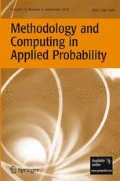Abstract
We consider MCMC algorithms for certain particle systems which include both attractive and repulsive forces, making their convergence analysis challenging. We prove that a version of these algorithms on a bounded state space is uniformly ergodic with explicit quantitative convergence rate. We also prove that a version on an unbounded state space is still geometrically ergodic, and then use the method of shift-coupling to obtain an explicit quantitative bound on its convergence rate.





Similar content being viewed by others
Change history
04 November 2021
The 6th author name and abstract text was updated.
References
Alder BJ, Wainwright TE (1959) Studies in molecular dynamics. I. General method. The J Chem Phys 31(2):459–466
Aldous DJ, Thorisson H (1993) Shift-coupling. Stochastic Processes and their Applications 44(1):1–14
Andrieu Christophe, De Freitas Nando, Doucet Arnaud, Jordan Michael I (2003) An introduction to mcmc for machine learning. Mach Learn 50(1):5–43
Asmussen S, Glynn PW, Thorisson H (1992) Stationarity detection in the initial transient problem. ACM Transactions on Modeling and Computer Simulation (TOMACS) 2(2):130–157
Barker AA (1965) Monte Carlo calculations of the radial distribution functions for a proton-electron plasma. Aust J Phys 18(2):119–134
Brooks S, Gelman A, Jones G, Meng XL (2011) Handbook of Markov chain Monte Carlo. CRC Press
Brooks SP, Gelman A (1996) General methods for monitoring convergence of iterative simulations. J Comput Graph Stat 7(4):434–455
Cohn Harry (1983) On the fluctuation of stochastically monotone Markov chains and some applications. J Appl Probab 20(1):178–184
Cowles MK, Carlin BP (1996) Markov Chain Monte Carlo Convergence Diagnostics: A Comparative Review. J Am Stat Assoc 91:883–904
Cowles MK, Roberts GO, Rosenthal JS (1999) Possible biases induced by MCMC convergence diagnostics. J Stat Comput Simul 64:87–104
Daley DJ (1968) Stochastically monotone Markov chains. Zeitschrift für Wahrscheinlichkeitstheorie und Verwandte Gebiete 10(4):305–317
Doeblin W (1938) Exposé de la théorie des chaınes simples constantes de markov á un nombre fini détats. Mathématique de l’Union Interbalkanique 2(77–105):78–80
Gelfand AE, Smith AFM (1990) Sampling-based approaches to calculating marginal densities. J Am Stat Assoc 85(410):398–409
Gelman Andrew, Rubin Donald B (1992) Inference from iterative simulation using multiple sequences. Stat Sci 7(4):457–472
Geman Stuart, Geman Donald (1984) Stochastic relaxation, Gibbs distributions, and the Bayesian restoration of images. IEEE Trans Pattern Anal Mach Intell 6(5–6):721–741
Geyer CJ (1992) Practical Markov chain Monte Carlo. Stat Sci 7:473–483
Hammersley JM (1972) Stochastic models for the distribution of particles in space. Adv Appl Probab 4:47–68
Hastings WK (1970) Monte Carlo sampling methods using Markov chain Monte Carlo. Biometrika 57:97–109
Jasra Ajay, Del Moral Pierre (2011) Sequential Monte Carlo methods for option pricing. Stoch Anal Appl 29(2):292–316
Jones Galin L, Hobert James P (2004) Sufficient Burn-in for Gibbs Samplers for a Hierarchical Random Effects Model. Ann Stat 32(2):784–817
Jones GL, Hobert JP (2001) Honest exploration of intractable probability distributions via Markov chain Monte Carlo. Statist. Sci. 16(4):312–334
Korteweg AG (2011) Markov chain Monte Carlo methods in corporate finance. Available at SSRN 1964923
Krauth W (2021) Event-chain Monte Carlo: foundations, applications, and prospects. https://arxiv.org/abs/2102.07217
Liggett TM (1978) Random invariant measures for Markov chains, and independent particle systems. Z. Warhschemlichkeitstheorie verw. Gebiete 45:297–313
Lund RB, Meyn SP, Tweedie RL (1996) Computable exponential convergence rates for stochastically ordered Markov processes. Ann. Appl. Probab. 6(1):218–237
Matthews P (1993) A slowly mixing Markov chain with implications for Gibbs sampling. Statistics and Probability Letters 17:231–236
Metropolis N, Rosenbluth AW, Rosenbluth MN, Teller AH, Teller E (1953) Equation of state calculations by fast computing machines. J Chem Phys 21(6):1087–1092
Meyn SP, Tweedie RL (2012) Markov Chains and Stochastic Stability. Springer Science & Business Media
Roberts GO, Rosenthal JS (1997) Shift-coupling and convergence rates of ergodic averages. Stoch Model 13(1):147–165
Roberts GO, Rosenthal JS (2004) General state space Markov chains and MCMC algorithms. Probab Surv 1:20–71
Roberts GO, Tweedie RL (1996) Geometric convergence and central limit theorems for multidimensional hastings and metropolis algorithms. Biometrika 83(1):95–110
Roberts GO, Tweedie RL (2000) Rates of convergence of stochastically monotone and continuous time Markov models. J Appl Probab 37(2):359–373
Rosenthal JS (1995) Minorization conditions and convergence rates for Markov chain Monte Carlo. J Am Stat Assoc 90:558–566
Rosenthal JS (2019) A First Look at Stochastic Processes. World Scientific Publishing Co.
Rosenthal JS (2020) Point process MCMC JavaScript simulation. Available at: probability.ca/pointproc
Ruslan S (2010) Learning deep Boltzmann machines using adaptive MCMC. ICML 2010 - Proceedings, 27th International Conference on Machine Learning, pages 943–950
Sanjib S (2017) Markov chain Monte Carlo methods for bayesian data analysis in astronomy. Ann Rev Astron Astrophys 55(1):213–259
Speagle JS (2020) A conceptual introduction to Markov chain Monte Carlo methods. https://arxiv.org/abs/1909.12313
Valderrama-Bahamóndez G, Fröhlich H (2019) MCMC techniques for parameter estimation of ODE based models in systems biology. Front Appl Math Stat 5:55
Chris W, Frederick AMIV (2015) Quantifying MCMC exploration of phylogenetic tree space. Syst Biol 64(3):472–491
Acknowledgements
We thank the editor and referee for very helpful suggestions which have led to many improvements of this paper.
Author information
Authors and Affiliations
Corresponding author
Additional information
Publisher’s Note
Springer Nature remains neutral with regard to jurisdictional claims in published maps and institutional affiliations.
Rights and permissions
About this article
Cite this article
Jiang, Y.H., Liu, T., Lou, Z. et al. Convergence Rates of Attractive-Repulsive MCMC Algorithms. Methodol Comput Appl Probab 24, 2029–2054 (2022). https://doi.org/10.1007/s11009-021-09909-y
Received:
Revised:
Accepted:
Published:
Issue Date:
DOI: https://doi.org/10.1007/s11009-021-09909-y




